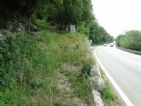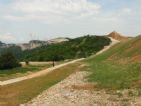
Bosco Artac
Comparisson reports are under license of:

Lo que dice el Arxiduc:
 “The foot of Artac Forest, covered in lively green fields, is a pleasant contrast compared to the up-to-now predominant barren setting. Here, in this corner of the world, the greatest differences in nature are very close to each other, only requiring a few steps to enter a totally different world. Here there is drought and a stone desert; there freshness, lively green, well-meaning and dark shade, seemingly finding yourself at the shores of a lake in the Alps than by the sea. Especially in the afternoons, when the fabulous rose-coloured mountains are reflected in the clear, smooth and always blue water and the shepherd drives his small herd of sheep or a few cows to the fields. It’s at that precise moment when the illusion would be almost perfect were it not for the sage, almost deceiving smell of the algae and the numerous seagulls in solemn flight, revealing the proximity of the sea. The beach itself, neighbour to narrow fields with low, yellowish slopes, consists of gravel and larger stones, with the branchy Staticia cancellataand the trembling, wind-blown Artemisia saxatilis growing in its cracks; the Plantago subulata with its yellow flower in dense bushes and other grasses also like the breeze from the sea.”
“The foot of Artac Forest, covered in lively green fields, is a pleasant contrast compared to the up-to-now predominant barren setting. Here, in this corner of the world, the greatest differences in nature are very close to each other, only requiring a few steps to enter a totally different world. Here there is drought and a stone desert; there freshness, lively green, well-meaning and dark shade, seemingly finding yourself at the shores of a lake in the Alps than by the sea. Especially in the afternoons, when the fabulous rose-coloured mountains are reflected in the clear, smooth and always blue water and the shepherd drives his small herd of sheep or a few cows to the fields. It’s at that precise moment when the illusion would be almost perfect were it not for the sage, almost deceiving smell of the algae and the numerous seagulls in solemn flight, revealing the proximity of the sea. The beach itself, neighbour to narrow fields with low, yellowish slopes, consists of gravel and larger stones, with the branchy Staticia cancellataand the trembling, wind-blown Artemisia saxatilis growing in its cracks; the Plantago subulata with its yellow flower in dense bushes and other grasses also like the breeze from the sea.”
A.L.S.: Buccari, Prague 1871
Datos proyecto Nixe III:
We weren’t able to climb to the same place the Archduke did, Artac Forest, but we did take another path which required we cross the road. The Archduke observed how the old road cut the forest in two. Today, we saw a rail line, the old road and a new highway, dividing the forest into four parts.
The vegetation we found here was like that described by Ludwig Salvator of Austria: Holm oaks, ash and fig trees and ivy. That notwithstanding, we also found carob and walnut trees which Archduke didn’t mention in his texts. Here are a few detailed photos of one of the carob trees ( Ceratonia siliqua) and one of the walnut trees ( Juglans regia) we saw.
Up high, after crossing the highway, we came across a Montpellier maple tree (Acer monspessulanum). It is a deciduous tree measuring only a few metres high. Its leaves are smooth and somewhat leathery, divided into three full lobes. Its flowers are very simple, yellowish-green in colour and grouped in panicles. It produces samaras with 2 winged seeds, forming a right angle. The tree’s bark is smooth and greyish, turning brown and crackled or cork-like with the passage of time.





















